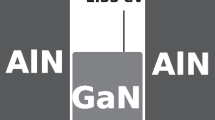Abstract
Semiconductor structures of the type of butyl-substituted erbium monophthalocyanine and triphthalocyanine are studied by Raman spectroscopy. It is shown that, when the sandwich-like structure of the molecule incorporating two complexing atoms between the ligands is considered instead of the planar molecular structure with one ligand and one metal atom, a series of lines appears in the Raman spectrum. In this series, the wave numbers of the lines represent an arithmetic progression with the arithmetical ratio ∼80 cm−1. It is suggested that this feature is due to the larger number of organic molecules per metal atom in the triphthalocyanine complex, and the four Raman peaks at the frequencies 122, 208, 280, and 362 cm−1 are the manifestation of slight out-of-plane vibrations of the phthalocyanine ligands.
Similar content being viewed by others
References
M. Pope and C. E. Swenberg, Electronic Processes in Organic Crystals (Clarendon, Oxford, 1982; Mir, Moscow, 1985).
G. N. Meshkova, A. T. Vartanyan, and A. N. Sidorov, Opt. Spektrosk. 43, 262 (1977) [Opt. Spectrosc. 43, 151 (1977)].
D. Xie, Y. Jiang, W. Pan, et al., Sens. Actuators B 81, 210 (2002).
D. Xie, W. Pan, Y. D. Jiang, and Y. R. Li, Mater. Lett. 57, 2395 (2003).
A. V. Ziminov, S. M. Ramsh, E. I. Terukov, et al., Fiz. Tekh. Poluprovodn. (St. Petersburg) 40, 1161 (2006) [Semiconductors 40, 1131 (2006)].
N. Ishikawa, T. Lino, and Y. Kaizu, J. Am. Chem. Soc. 124, 11 440 (2002).
V. E. Pushkarev, M. O. Breusova, E. V. Shulishov, and Yu. V. Tomilov, Russ. Chem. Bull. Int. Ed. 54, 2087 (2005).
D. A. Tsirkunov, in Proceedings of 16th International Crimean Conference on Microwave and Telecommunication Technology (Sevastopol, Ukraine, 2006), p. 683.
F. Lu, J. Cui, and X. Yan, Spectrochim. Acta A 63, 550 (2006).
M. Bao, R. Wang, L. Rintoul, et al., Vibr. Spectrosc. 40, 47 (2006).
M. Bao, Y. Bian, L. Rintoul, et al., Vibr. Spectrosc. 34, 283 (2004).
Author information
Authors and Affiliations
Corresponding author
Additional information
Original Russian Text © I.A. Belogorokhov, E.V. Tikhonov, M.O. Breusova, V.E. Pushkarev, A.V. Zoteev, L.G. Tomilova, D.R. Khokhlov, 2007, published in Fizika i Tekhnika Poluprovodnikov, 2007, Vol. 41, No. 11, pp. 1381–1383.
Rights and permissions
About this article
Cite this article
Belogorokhov, I.A., Tikhonov, E.V., Breusova, M.O. et al. Raman scattering in semiconductor structures based on monophthalocyanine and triphthalocyanine molecules incorporating erbium ions. Semiconductors 41, 1361–1363 (2007). https://doi.org/10.1134/S1063782607110164
Received:
Accepted:
Issue Date:
DOI: https://doi.org/10.1134/S1063782607110164




